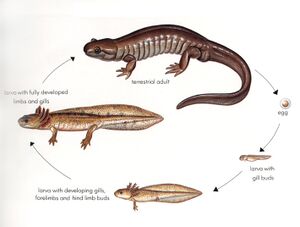Salamanders

Description
Salamanders are a group of amphibians in the order Caudata [1], with over 740 species of salamander in 10 families, with the largest family being Cryptobranchidae [1]. Salamanders are characterized as amphibians which have tails as adults, which store fats and proteins and assists with movement [1]. Salamanders are typically small animals, usually reaching no more than 4 to 6 inches when fully grown [1]. However, there are notable exceptions, with some species reaching much larger sizes. Most notably, the Japanese giant salamander can reach up to 5.6 feet in length [1]. Other well known examples of salamanders include axolotls, hellbenders, sirens, and newts [1]. Salamanders can be found in temperate and tropical climates worldwide, with most of their diversity occurring in temperate regions of the northern hemisphere [1].
Habitat and Range
Salamanders can be found throughout almost the entire northern hemisphere with the one exception being the Amazon basin in South America [3]. The greatest amount of salamander diversity can be found in the United States, with all but one of the families being found there, the Hynobiidae or Asiatic salamanders [2]. All species of salamanders require access to a nearby water source, as it is essential for them to keep their skin moist in order to survive [2]. Some groups, particularly newts, spend most of their time out of the water while others, such as hellbenders, are almost fully aquatic [2]. Some other species are cave specialists and spend most, if not all of their lives in total darkness [4]. Salamanders of all species tend to be secretive, and burrow in moist leaf litter to avoid being seen [5].
Life Cycle

Salamanders are amphibians and like most amphibians they reproduce by laying eggs. In most species, reproduction is done via internal fertilization, although a few species use external fertilization [3]. After fertilization, eggs are typically laid in clusters in shallow water. Some species however, lay eggs in moist terrestrial locations, such as under logs or on leaves [3]. Once the eggs are laid, it is common for the female to stay with them until they hatch [3]. Most salamander species begin their lives as a fully aquatic larva which then undergoes a metamorphosis before transitioning to a more terrestrial adult [3]. Not all species do this though. A number of species never fully metamorphize and the adults retain several juvenile features, a process called paedomorphosis [3]. The most well known species to undergo paedomorphosis is the Axolotl [3].

Diet
All species of salamanders are carnivores with insects being the most common prey item [3]. Diet does vary widely across species, mostly depending on the size of a particular species. Small salamanders eat mostly insects and other small invertebrates, while some of the largest species have diets that include larger prey items which can include fish, crustaceans, and small mammals [4]. Salamanders are mostly slow moving animals and this limits their ability to catch fast prey items [4]. This limitation is partially made up for in some, mostly tropical, species which have specialized tongues that can be rapidly protruded from the mouth to grab prey items [3].
References
[1] salamander | Species, lifestyle, & facts. (n.d.).. https://www.britannica.com/animal/salamander
[2] Facts About Salamanders | Live Science. 2015, October 29.. https://www.livescience.com/52627-salamanders.html
[3] Caudata | Characteristics & Facts | Britannica. (n.d.).. https://www.britannica.com/animal/Caudata
[4] Salamander and Newt | San Diego Zoo Animals & Plants. (n.d.).. https://animals.sandiegozoo.org/animals/salamander-and-newt#:~:text=HABITAT%20AND%20DIET,dug%20in%20the%20damp%20earth.
[5] Spotted salamander. (n.d.). . https://portal.ct.gov/DEEP/Wildlife/Fact-Sheets/Spotted-Salamander.